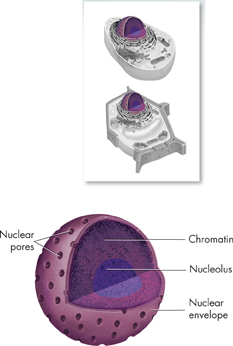Comparing the Cell to a Factory In some respects, the eukaryotic cell is much like a living version of a modern factory (Figure 7–6). The different organelles of the cell can be compared to the specialized machines and assembly lines of the factory. In addition, cells, like factories, follow instructions and produce products. As we look through the organization of the cell, we'll find plenty of places in which the comparison works so well that it will help us understand how cells work.
The Nucleus In the same way that the main office controls a large factory, the nucleus is the control center of the cell.  The nucleus contains nearly all the cell's DNA and, with it, the coded instructions for making proteins and other important molecules. Prokaryotic cells lack a nucleus, but they do have DNA that contains the same kinds of instructions.
The nucleus contains nearly all the cell's DNA and, with it, the coded instructions for making proteins and other important molecules. Prokaryotic cells lack a nucleus, but they do have DNA that contains the same kinds of instructions.
The nucleus, shown in Figure 7–7, is surrounded by a nuclear envelope composed of two membranes. The nuclear envelope is dotted with thousands of nuclear pores, which allow material to move into and out of the nucleus. Like messages, instructions, and blueprints moving in and out of a factory's main office, a steady stream of proteins, RNA, and other molecules move through the nuclear pores to and from the rest of the cell.
Chromosomes, which carry the cell's genetic information, are also found in the nucleus. Most of the time, the threadlike chromosomes are spread throughout the nucleus in the form of chromatin—a complex of DNA bound to proteins. When a cell divides, its chromosomes condense and can be seen under a microscope. You will learn more about chromosomes in later chapters.
Most nuclei also contain a small dense region known as the nucleolus (noo KLEE uh lus). The nucleolus is where the assembly of ribosomes begins.
 In Your Notebook Describe the structure of the nucleus. Include the words nuclear envelope, nuclear pore, chromatin, chromosomes, and nucleolus in your description.
In Your Notebook Describe the structure of the nucleus. Include the words nuclear envelope, nuclear pore, chromatin, chromosomes, and nucleolus in your description.

FIGURE 7–7 The Nucleus The nucleus controls most cell processes and contains DNA. The small, dense region in the nucleus is known as the nucleolus.
dTable of Contents
- Formulas and Equations
- Applying Formulas and Equations
- Mean, Median, and Mode
- Estimation
- Using Measurements in Calculations
- Effects of Measurement Errors
- Accuracy
- Precision
- Comparing Accuracy and Precision
- Significant Figures
- Calculating With Significant Figures
- Scientific Notation
- Calculating With Scientific Notation
- Dimensional Analysis
- Applying Dimensional Analysis




